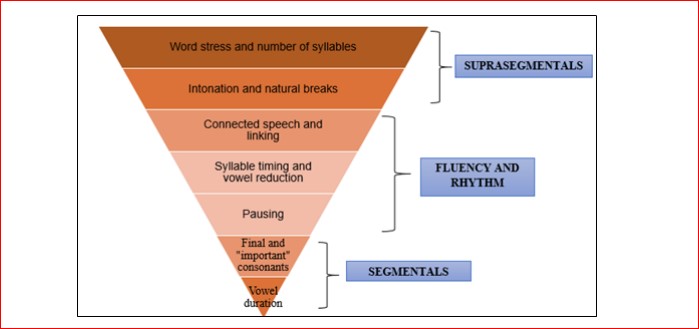
How To Teach Suprasegmentals In The ESL Classroom?
12th June 2024
Anything that isn't a stand-alone sound, such as tone, rhythm, or loudness, is referred to as a suprasegmental in speech. They convey grammatical distinctions, emotions, and coherence that a natural speaker would detect right away. Understanding these elements in theory and practice is crucial for ESL students. We'll go over three essential suprasegmentals in the English language stress, rhythm, and intonation as well as how to teach them in an ESL classroom below.
What Are The Suparsegmental Aspects Of Pronunciations?

There are 3 elements of pronunciation in an ESL classroom. These include:
1. Stress
The way a word or syllable is accentuated when spoken aloud is known as stress. It frequently aids in expressing emotion and has the power to completely alter the meaning of a word or phrase. One distinctive feature of English writing is the large number of unmarked stress tones.
Consider the Spanish language, which employs accent marks to denote the emphasized portion of words when spoken. Since the English language lacks these indications, it can be difficult for new learners to pick up patterns of pronouncing multisyllabic words.
The three types of stress in the English language involve:
- Word Stress
- Syllable Stress
- Sentence Stress
Do you follow us on Social Media? We regularly share upgraded educational content, tips, feedback, and more. Check us out by clicking the profiles here – Facebook / Twitter / LinkedIn / Pinterest / Instagram / YouTube
2. Rhythm
Frequently, when one hears the term rhythm, they think of music. It's a fitting analogy for ESL! The rhythm of speech is determined by the timing of breaths, pauses, hand gestures, and facial emotions. Rhythm involves conveying patterns in sentences that come together to produce a coherent idea, as well as emphasizing different words and syllables.
These components all complement one another. Speaking with rhythm is a dance, and one of the things that sets excellent English teachers apart from exceptional English teachers in the ESL classroom is their ability to teach pupils the steps to this dance.
3. Intonations
Intonations are used to show comedy, seriousness, or attitude. It's time for your kids to learn how to utter a word correctly once they've mastered the textbook pronunciation. Which vocal pitch, loudness, and tone would most effectively convey the message being conveyed? By enabling the listener to fully comprehend the speaker's priorities, intonation enhances communication and comprehension.
To highlight and convey attitude, feeling, or the main idea of the statement being said, intonation is employed. In communication, tone plays a critical role in establishing genuine connections. Even if the words aren't uttered precisely, the correct meaning can still be conveyed by using the appropriate tone. Simply said, the tone at the beginning of English serves to convey the purpose of the speech. As pupils progress, intonation is employed to indicate the relationship between concepts in the discourse.
Activities To Teach Stress To ESL Students
Here are a few ideas to teach Stress To ESL Students:
- Rubber Bands
Practice elongating syllables with elastic bands to pick up speaking patterns for vocabulary words. This easy method helps engage both neuron firing and muscle memory during speech by using the mind-body link. Both younger and older students may enjoy themselves with this practice, which also serves as an excellent means of illustrating phrase patterns.
- Annotations
Experiment with capitalization, circling and underlining to emphasize the minute variations in word and sound emphasis in speech. As is often the case, learning will be greatly aided by making various links in memory and learning.
- Songs
To illustrate the fixed patterns in English, use songs. No matter how long or quickly a speech is uttered, counting syllables can assist show that the stress is always in the same locations in a sentence.
How To Teach Rhythm To ESL Students?
These are some excellent strategies for assisting pupils in finding their speech rhythm:
- Write It Out
For an effective way to illustrate lifts, pauses, and pentameter, try using colored markers or chalk. By using this technique, changes that would be difficult for the ear to detect can be given a visual indication. Encourage student participation by giving them a color to use and allowing them to annotate the statement that is put on the board! For stressed syllables, use dots; for drawn-out sounds, use lines; and for tone dips, use downward and upward arrows.
- Repetition
Use interesting and entertaining poetry, songs, and phrases, and make use of terminology that your kids might be struggling with. Giving kids an example word to write as many rhyming words as they can is a terrific teaching practice. As children pick up new terminology, any material that makes use of repetition will assist them in remembering information and identifying patterns.
- Clapping
There are several applications for the mind-body relationship in education. One of the best ways to teach children about tempo and stress together is to have them express emphasis and rhythm by clapping. This exercise will show you that speed and rhythm are not the same thing.
How To Teach Intonations To ESL Students?
These are a few entertaining and thought-provoking intonation exercises for teaching English:
- Hear And Feel
Give each student a few sentences to utter and urge them to talk as freely as they can. Their students are to make educated guesses as to the feeling they are attempting to convey. Keep in mind that tone often matters more in English than word choice does!
- Use Improv Games
In class, engage in some improv games! Give pupils a task to do in pairs: pretend to converse with one another in a variety of situations. The game's objective is to demonstrate how intonation changes based on the context of a scenario.
- Tie It All Together
All of the teachings we have already covered on suprasegmentals are combined in one practice. You read aloud a few phrases, and then you ask your kids to point out anything that doesn't belong. This practice aims to assist students in integrating their knowledge of intonation, rhythm, and stress simultaneously.
Make Learning Easy And Fun
Even if students learn every word in the English language by heart, they won't be able to convey the deeper meaning of their interactions if they lack the contextual speaking abilities to support it. For ESL students of all ages to acquire excellent speaking and listening abilities, educators can have a Bachelor of Education (B.Ed.) in TESOL, so that they can teach suprasegmentals easily.
We believe education should be accessible for everyone. That’s why we don’t charge for our blogs. Find the right course that will help you in your career with us, contact us at +6621056101. You can mail us at act@asiancollegeofteachers.com
Written By : Park Jin Ae




